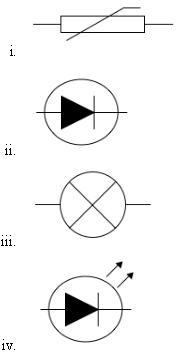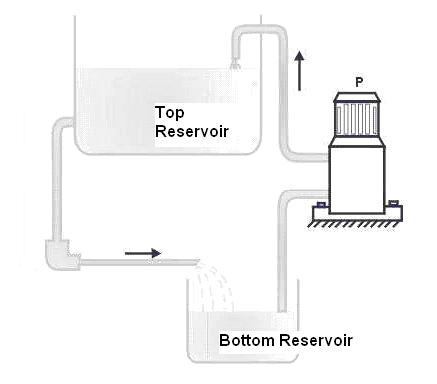Current Electricity Basic Concept
.webp)
Complusory Reflection Quiz. Only attempt when you are ready and confident.
- 1.
Which of the following represent a light bulb?
- A.
I
- B.
Ii
- C.
Iii
- D.
Iv
Correct Answer
C. IiiExplanation
Option iii represents a light bulb.Rate this question:
-
- 2.
______ is defined as the energy converted from electrical to other forms when one coulomb of electrical charge passes between the two points.
- A.
Current
- B.
Potential difference between any 2 points
- C.
Electromotive force
- D.
Resistance
Correct Answer
B. Potential difference between any 2 points -
- 3.
For a solid conductor, what is the name of the particle that carries a chargeand hence creates current call?
- A.
Electron
- B.
Proton
- C.
Neutron
- D.
None of the above
Correct Answer
A. ElectronExplanation
An electron is a negatively charged particle that carries a charge and creates current in a solid conductor. It is the movement of electrons that constitutes an electric current. Protons and neutrons, on the other hand, are particles found in the nucleus of an atom and do not move freely within a conductor to create current. Therefore, the correct answer is electron.Rate this question:
-
- 4.
This simplified diagram represents a cyclic movement of water where there is a pump, P, to pump water up to a higher level reservoir. The water flows down to the bottom reservoir, which is then again pumped up. Now imagine that this can represent an electric circuit. Which part of the diagram will represent the battery?
- A.
The top reservoir
- B.
The pump
- C.
The piping
- D.
The bottom reservoir
Correct Answer
B. The pumpExplanation
In an electric circuit, the battery is responsible for providing the energy that drives the flow of electric current. Similarly, in the given diagram, the pump plays the role of the battery by providing the energy to pump the water up to the higher level reservoir. Just like the battery in an electric circuit, the pump is the component that initiates the movement and drives the flow of the water in the cyclic movement. Therefore, the pump represents the battery in this simplified diagram.Rate this question:
-
- 5.
This simplified diagram represents a cyclic movement of water where there is a pump, P, to pump water up to a higher level reservoir. The water flows down to the bottom reservoir, which is then again pumped up. Now imagine that this can represent an electric circuit. Identify the positive pole of the “battery” in this diagram
- A.
The left hand side of the top reservoir
- B.
The top part of the pump
- C.
The bottom part of the piping where the water flow from the top reservoir to the bottom
- D.
The right hand side of the bottom reservoir
Correct Answer
B. The top part of the pumpExplanation
The top part of the pump can be identified as the positive pole of the "battery" in this diagram because it is responsible for pumping the water up to a higher level reservoir, which is analogous to the positive terminal of a battery that provides the electrical energy for the circuit.Rate this question:
-
- 6.
This simplified diagram represents a cyclic movement of water where there is a pump, P, to pump water up to a higher level reservoir. The water flows down to the bottom reservoir, which is then again pumped up. Now imagine that this can represent an electric circuit. What is analogous to the water in an electric circuit?
- A.
Conventional Current
- B.
Electron
- C.
Electromotive force
- D.
Potential difference
Correct Answer
B. ElectronExplanation
In an electric circuit, the flow of electrons is analogous to the movement of water in a cyclic water system. Just like water flows from the higher level reservoir to the bottom reservoir, electrons flow from a higher potential to a lower potential in an electric circuit. Therefore, the correct answer is "Electron."Rate this question:
-
- 7.
This simplified diagram represents a cyclic movement of water where there is a pump, P, to pump water up to a higher level reservoir. The water flows down to the bottom reservoir, which is then again pumped up. Now imagine that this can represent an electric circuit. How would you measure the “current” of this “circuit”?
- A.
Measure the rate of water flow
- B.
Measure the weight of the water
- C.
Measure the density of the liquid used
- D.
Measure the amount of energy required by the pump to pump the water up
Correct Answer
A. Measure the rate of water flowExplanation
To measure the "current" of this "circuit", we can use the analogy of water flow. Just like the rate of water flow represents the amount of water passing through a certain point in a given time, the current in an electric circuit represents the flow of electric charge. Therefore, measuring the rate of water flow in this simplified diagram would be equivalent to measuring the current in the electric circuit.Rate this question:
-
- 8.
This simplified diagram represents a cyclic movement of water where there is a pump, P, to pump water up to a higher level reservoir. The water flows down to the bottom reservoir, which is then again pumped up. Now imagine that this can represent an electric circuit. Where is the “resistor”?
- A.
The pump
- B.
The bottom reservoir
- C.
The part where the water fall through the pipe
- D.
The end of the pipe where the water gushes out into the bottom reservoir
Correct Answer
C. The part where the water fall through the pipeExplanation
In an electric circuit, the "resistor" is a component that restricts the flow of electric current. In the given diagram, the part where the water falls through the pipe can be compared to a resistor in an electric circuit. Just like a resistor limits the flow of current, the pipe restricts the flow of water as it falls from a higher level to the bottom reservoir. Therefore, the correct answer is the part where the water falls through the pipe.Rate this question:
-
- 9.
4.0 J of electrical energy is converted to thermal energy when 6.0 C ofcharges pass through a resistor. What is the potential difference across the resistor?
- A.
0.67V
- B.
1.5V
- C.
24V
- D.
Cannot be determined due to lack of information
Correct Answer
A. 0.67VExplanation
The potential difference across the resistor can be determined using the formula: Potential difference = Electrical energy / Charges. In this case, the electrical energy is given as 4.0 J and the charges are given as 6.0 C. Therefore, the potential difference across the resistor is 4.0 J / 6.0 C = 0.67V.Rate this question:
-
- 10.
One ______is the p.d. across a load if the work done to bring 1 C ofpositive charge across the load is 1 J.
- A.
Ohm
- B.
Ampere
- C.
Volt
- D.
None of the above
Correct Answer
C. VoltExplanation
The correct answer is "Volt". Volt is the unit of measurement for electric potential difference, also known as voltage. It represents the amount of work done to move a positive charge of 1 Coulomb across a load. Therefore, the p.d. across a load is measured in volts.Rate this question:
-
- 11.
To transfer 2.0C of charge from point A to B (where its potentialdifference is 4.0 V) in a circuit. How much energy is needed?
- A.
2.0 J
- B.
6.0 J
- C.
0.50 J
- D.
8.0 J
Correct Answer
D. 8.0 JExplanation
The energy needed to transfer charge from point A to B can be calculated using the formula: energy = charge x potential difference. In this case, the charge is given as 2.0C and the potential difference is given as 4.0V. Plugging these values into the formula, we get: energy = 2.0C x 4.0V = 8.0 J. Therefore, the correct answer is 8.0 J.Rate this question:
-
- 12.
In an electric discharge, a total of 150 C of charges flows into the earth in 1.50 minutes. What is the average current?
- A.
1.67 A
- B.
60.0 A
- C.
100 A
- D.
225 A
Correct Answer
A. 1.67 AExplanation
The average current can be calculated by dividing the total charge by the time it takes for the charge to flow. In this case, the total charge is 150 C and the time is 1.50 minutes. Dividing 150 C by 1.50 minutes gives us an average current of 1.67 A.Rate this question:
-
- 13.
Which of the flowing constitutes an electric current?I A flow of electronsII A flow of positive ionsIII A lightning discharge
- A.
II only correct.
- B.
I and II are correct.
- C.
II and III are correct.
- D.
I, II and III are correct.
Correct Answer
D. I, II and III are correct. -
- 14.
The carriers of a current in a wire are electrons. Each electron carries 1.6 x 10-19C of charge. The number of electrons per second passing any section of a wire carrying a current of 0.8 A is
- A.
3 x 10^18
- B.
5 x 10^18
- C.
8 x 10^18
- D.
8 x 10^19
Correct Answer
B. 5 x 10^18Explanation
In order to find the number of electrons passing through a wire per second, we can use the formula: number of electrons = (current * time) / charge of each electron. Given that the current is 0.8 A and the charge of each electron is 1.6 x 10^-19 C, we can plug in these values to calculate the number of electrons passing through the wire per second. The calculation yields 5 x 10^18, which is the correct answer.Rate this question:
-
- 15.
The difference in potential between a cloud and earth is 1.0 x 109 V. In a lightning discharge from the cloud to earth, a charge of 20 C passes. Calculate the energy involved in this discharge.
- A.
0.50 x 10^ -8
- B.
0.50 x 10^8
- C.
2.0 x 10^ -8
- D.
2.0 x 10^10
Correct Answer
D. 2.0 x 10^10Explanation
The energy involved in a discharge can be calculated using the formula E = qV, where E is the energy, q is the charge, and V is the potential difference. In this case, the charge is given as 20 C and the potential difference is given as 1.0 x 10^9 V. Plugging these values into the formula, we get E = 20 C x 1.0 x 10^9 V = 2.0 x 10^10 J. Therefore, the correct answer is 2.0 x 10^10.Rate this question:
-
Quiz Review Timeline +
Our quizzes are rigorously reviewed, monitored and continuously updated by our expert board to maintain accuracy, relevance, and timeliness.
-
Current Version
-
Mar 26, 2024Quiz Edited by
ProProfs Editorial Team -
Jan 20, 2011Quiz Created by
Ms_adelinetan
 Back to top
Back to top




